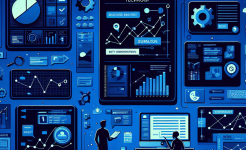The burndown chart is particularly valuable in agile project management methodologies, where flexibility and adaptability are key. By providing a visual representation of the remaining work, the burndown chart helps teams to stay focused on their goals and to identify any deviations from the planned trajectory. This allows for timely interventions, ensuring that the project remains aligned with its objectives. Moreover, the burndown chart fosters transparency and accountability within the team, as everyone can see the progress being made and the work that still needs to be completed.
In addition to its practical benefits, the burndown chart also serves as a powerful motivational tool. Seeing the amount of work decreasing over time can boost team morale and encourage a sense of accomplishment. This is particularly important in long-term projects, where maintaining momentum and motivation can be challenging. By providing a clear visual representation of progress, the burndown chart helps to keep the team engaged and focused on the end goal, ultimately contributing to the successful delivery of the project.
Understanding the Burndown Chart
A burndown chart is a graphical representation that shows the amount of work remaining in a project over time. The horizontal axis represents time, typically in days or sprints, while the vertical axis represents the amount of work remaining, often measured in story points or hours. The chart usually includes two lines: the ideal burndown line, which represents the expected progress if everything goes according to plan, and the actual burndown line, which shows the real progress made by the team.
The ideal burndown line is a straight diagonal line that starts at the total amount of work at the beginning of the project and ends at zero by the project's deadline. This line serves as a benchmark against which the actual progress can be measured. The actual burndown line, on the other hand, is a more jagged line that fluctuates based on the team's performance. By comparing the two lines, project managers can quickly identify whether the project is on track, ahead of schedule, or behind schedule.
One of the key advantages of the burndown chart is its simplicity. Unlike other project management tools that can be complex and difficult to interpret, the burndown chart provides a straightforward visual representation of progress. This makes it easy for team members, stakeholders, and project managers to understand the current status of the project at a glance. Additionally, the burndown chart can be updated in real-time, providing an up-to-date picture of the project's progress and allowing for quick adjustments as needed.
Benefits of Using a Burndown Chart
The use of a burndown chart offers numerous benefits that contribute to the successful delivery of a project. First and foremost, it provides transparency. By displaying the amount of work remaining and the progress made, the burndown chart ensures that everyone involved in the project is on the same page. This transparency fosters a sense of shared responsibility and encourages team members to take ownership of their tasks. It also helps to prevent misunderstandings and miscommunications, as the current status of the project is clearly visible to all.
Another significant benefit of the burndown chart is its ability to highlight potential issues early on. If the actual burndown line starts to deviate significantly from the ideal burndown line, it is a clear indication that something is amiss. This early warning system allows project managers to identify and address problems before they escalate, minimizing the risk of delays and cost overruns. For example, if the team is consistently falling behind schedule, the project manager can investigate the root cause, whether it be resource constraints, scope creep, or other factors, and take corrective action.
Finally, the burndown chart serves as a motivational tool for the team. Seeing the amount of work decreasing over time can be incredibly satisfying and can boost team morale. This is particularly important in long-term projects, where maintaining motivation can be challenging. The burndown chart provides a tangible representation of progress, helping to keep the team focused and engaged. It also encourages a sense of accomplishment as the team works towards completing the project, which can be a powerful driver of performance and productivity.
Implementing a Burndown Chart in Your Project

Implementing a burndown chart in your project is a relatively straightforward process, but it requires careful planning and execution. The first step is to define the scope of the project and break it down into manageable tasks. These tasks should be assigned story points or hours, which will serve as the basis for the burndown chart. It is important to ensure that the tasks are well-defined and that the estimates are realistic, as this will directly impact the accuracy of the chart.
Once the tasks have been defined and estimated, the next step is to create the burndown chart. This can be done using project management software, such as Jira, Trello, or Microsoft Project, or it can be created manually using a spreadsheet. The chart should include the ideal burndown line, which represents the expected progress, and the actual burndown line, which will be updated as the team completes tasks. It is important to update the chart regularly, ideally on a daily basis, to ensure that it provides an accurate reflection of the project's progress.
Finally, it is crucial to use the burndown chart as a tool for communication and collaboration. The chart should be shared with the entire team and discussed during regular meetings, such as daily stand-ups or sprint reviews. This will ensure that everyone is aware of the project's status and can contribute to identifying and addressing any issues. Additionally, the burndown chart can be used to set goals and milestones, providing the team with clear targets to work towards. By using the burndown chart in this way, project managers can enhance team collaboration, improve communication, and ultimately increase the likelihood of project success.
Conclusion
In conclusion, the burndown chart is an invaluable tool in project delivery, offering a clear and concise way to track progress, identify potential issues, and ensure that the project stays on track. Its simplicity and transparency make it accessible to all team members, fostering a sense of shared responsibility and accountability. By providing an early warning system for potential problems, the burndown chart allows project managers to take timely corrective action, minimizing the risk of delays and cost overruns. Additionally, the burndown chart serves as a powerful motivational tool, helping to keep the team engaged and focused on the end goal.
The benefits of using a burndown chart are numerous, and its implementation can significantly enhance the success of a project. By breaking down the project into manageable tasks, creating an accurate and up-to-date chart, and using it as a tool for communication and collaboration, project managers can ensure that their teams remain aligned with the project's objectives. The burndown chart is not just a tracking tool; it is a strategic asset that can drive project success and deliver value to all stakeholders.
Ultimately, the burndown chart is a testament to the power of visualization in project management. By providing a clear and visual representation of progress, it enables teams to stay focused, make informed decisions, and achieve their goals. Whether you are managing a small project or a large, complex initiative, the burndown chart is a tool that can help you deliver value and achieve success.
FAQ
What is the difference between a burndown chart and a burnup chart?
A burndown chart shows the amount of work remaining over time, typically starting from the total work and decreasing as tasks are completed. In contrast, a burnup chart shows the amount of work completed over time, starting from zero and increasing as tasks are finished. Both charts are useful, but the burndown chart is often preferred for its simplicity and focus on remaining work.
How often should a burndown chart be updated?
A burndown chart should ideally be updated on a daily basis, especially in agile projects where progress is tracked in short iterations or sprints. Regular updates ensure that the chart provides an accurate and up-to-date reflection of the project's progress, allowing for timely interventions and adjustments.
Can a burndown chart be used in non-agile projects?
Yes, a burndown chart can be used in non-agile projects, although it is most commonly associated with agile methodologies. The principles of tracking remaining work and visualizing progress are applicable to any project management approach. However, the chart may need to be adapted to fit the specific needs and structure of the project.
ARTICLE TITLE :Value of burndown chart in project delivery ,AUTHOR :ITpmlib

















